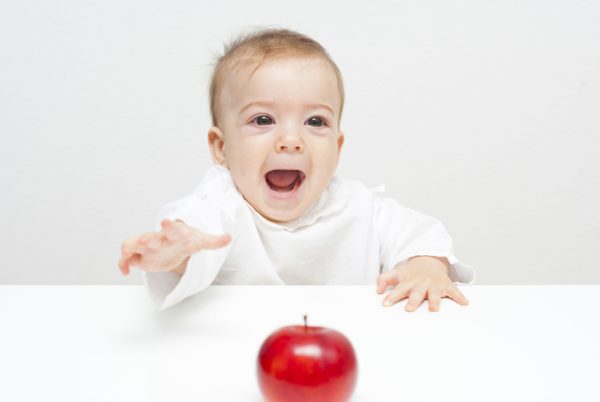Montessori and Breastfeeding: Weaning
Weaning is a sensitive subject in most all child-rearing circles. Montessori and weaning is no different, though we would like to think our community is accepting of however a mother ultimately decides to raise her little ones.
There are many different ways to wean a baby and ultimately, they are all successful (eventually). After all, babies will learn to eat solids with or without us! If you’re already a Montessorian or you’re thinking about becoming one, you might be interested in what Montessori has to say about the weaning process, though. So, let’s get started:

What Does the Montessori Literature Say About Weaning?
A word of caution about the Montessori literature on breastfeeding and weaning: some of it is completely outdated. If you’re reading Montessori books that are decades old, take the advice about weaning with a grain of salt.
Times have changed, after all. Dr. Montessori was a scientist at heart, and it’s likely she would accept what we know about breastfeeding and weaning today if shown the data.
Montessori Weaning Tips and Guidelines
In this article, you’ll find several contemporary weaning tips that are compatible with Montessori child development principles. As you’re taking in all of this information, remember that these are simply suggestions. As such, they are meant to be helpful, not prescriptive and certainly not judgmental.
At the end of the day, you know your baby and your family best. That makes you the ultimate expert here, and you get to call the shots as to exactly how things are done in your household—weaning included!
Follow the Child Baby
In Montessori, the phrase “follow the child” is one you’ll hear over and over again. Similarly, when it comes to weaning, it’s best to “follow the baby.” Just as we respect the child when it comes to learning, the same approach is taken in making the transition from breast to solid foods.
Babies are instinctual, and in many ways, they really do know what is best for them—it’s our job as parents to observe our little ones and follow their lead. That means looking for signs that your baby is ready to start the weaning process.
In Montessori, we call this a sensitive period when your child begins to take interest in learning something new.

During the sensitive period of weaning, your baby may begin watching you intently as you enjoy your meals, for example. He or she may even start mimicking you as you open and close your mouth to eat.
Other signs your little one is ready for weaning include chewing on hands and/or toys, sitting up with support, and teething. While all babies are different, the weaning process is usually initiated at or around 6 months of age, so you’ll want to start looking for these signs around this time.
Take Your Time
Of course, the fact that babies usually begin the transition to solids around the 6-month mark doesn’t mean that they’ll be completely weaned shortly thereafter. It’s a process, so don’t rush yourself or your little one.
For one thing, weaning is often an emotional time for parents, especially moms who are used to being the primary source of sustenance for their youngsters. It’s also a huge transition for babies as they begin to (quite literally) pull away from their mothers and start making strides toward greater autonomy and independence.
For these reasons, it’s important to remember that weaning is a slow and steady process, not a race to the finish! Take your time, and be patient with yourself and your baby.
Give Your Baby the Necessary Tools to Succeed
Highchairs, suctioned plastic dishes, and finger feeding are mainstays of traditional parenting, but if you want to do things a bit differently, you may consider the Montessori approach to weaning. With this method, the child is given all of the same tools for eating that a grown-up would have, just in smaller proportions.
Child-size metal utensils, glass dishes, and a weaning table are commonly used in Montessori homes as a way of setting children up for success with the weaning process. This method is also a way of expressing respect for the child as a member of the family who can now participate in normal mealtime rituals and traditions.

As your baby begins to use the same eating utensils and tools as mom and dad, he or she will begin to feel a greater sense of confidence and independence. This boost in self-esteem goes a long way towards getting your little one excited about the weaning process.
It also provides a great foundation for practicing table manners and etiquette later on. In addition, the weaning table as opposed to a highchair also helps with feelings of autonomy as the child is able to get to and from the table without assistance.
Set A Good Example
In Montessori, we often talk about the importance of observing the child. Remember, though, that your little one is also watching you!
During the weaning period, it’s crucial that you set a good example for your baby when you’re eating. Be demonstrative in your actions when it comes to picking up utensils, putting morsels of food in your mouth, and chewing.
Show your child that it is an enjoyable process that he or she can delight in. After all, if your little one is enjoying mealtime, it will become something to look forward to rather than dreading.
This will pave the way for many wonderful memories to be made around the table as a family!

Weaning is certainly a complicated time for families. It can cause confusion, frustration, and even sadness that a period of intense bonding has passed.
At the same time, weaning is a milestone to be celebrated as your little one is becoming more independent and more capable than ever before!
As a final word of advice, simply savor these moments in your child’s journey of development and trust your instinctual urge to encourage him or her throughout the weaning process.
Cheers and don't forget to subscribe!
